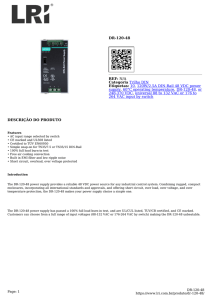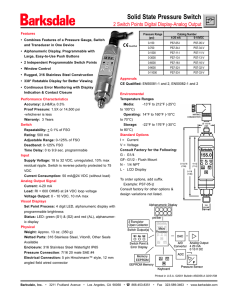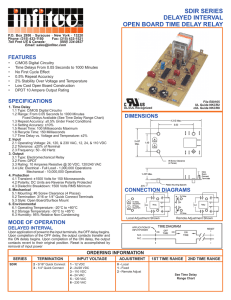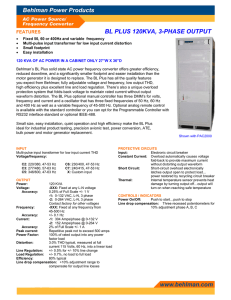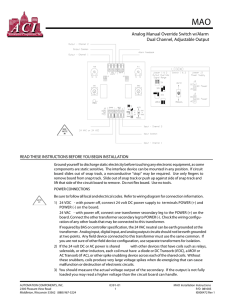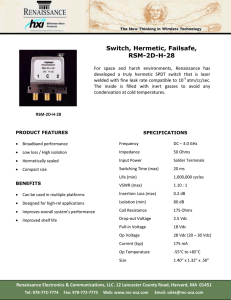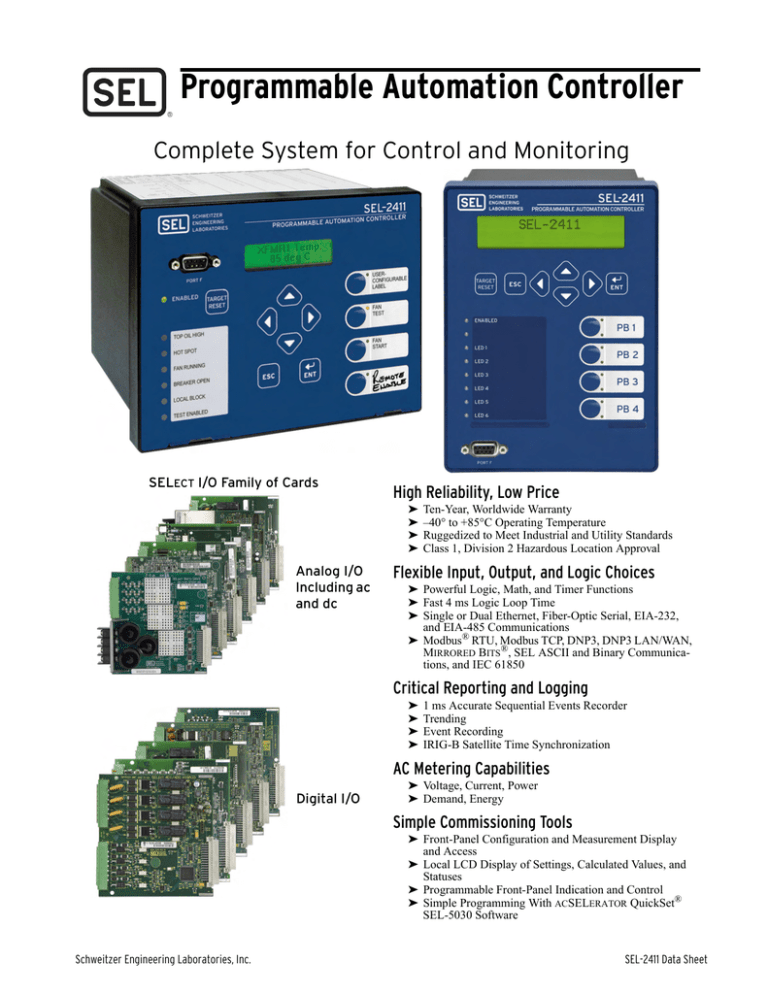
Programmable Automation Controller
Complete System for Control and Monitoring
SELECT I/O Family of Cards
High Reliability, Low Price
➤
➤
➤
➤
Analog I/O
Including ac
and dc
Ten-Year, Worldwide Warranty
–40° to +85°C Operating Temperature
Ruggedized to Meet Industrial and Utility Standards
Class 1, Division 2 Hazardous Location Approval
Flexible Input, Output, and Logic Choices
➤ Powerful Logic, Math, and Timer Functions
➤ Fast 4 ms Logic Loop Time
➤ Single or Dual Ethernet, Fiber-Optic Serial, EIA-232,
and EIA-485 Communications
➤ Modbus® RTU, Modbus TCP, DNP3, DNP3 LAN/WAN,
MIRRORED BITS®, SEL ASCII and Binary Communications, and IEC 61850
Critical Reporting and Logging
➤
➤
➤
➤
1 ms Accurate Sequential Events Recorder
Trending
Event Recording
IRIG-B Satellite Time Synchronization
AC Metering Capabilities
Digital I/O
➤ Voltage, Current, Power
➤ Demand, Energy
Simple Commissioning Tools
➤ Front-Panel Configuration and Measurement Display
and Access
➤ Local LCD Display of Settings, Calculated Values, and
Statuses
➤ Programmable Front-Panel Indication and Control
➤ Simple Programming With ACSELERATOR QuickSet®
SEL-5030 Software
Schweitzer Engineering Laboratories, Inc.
SEL-2411 Data Sheet
2
Product Summary
The SEL-2411 Programmable Automation Controller (SEL-PAC) automates continuous and discrete processes. A standalone SEL-PAC is a simple solution to monitor and control small waste water plants or small substations. Combine multiple SEL-PACs for applications such as industrial powerhouse DCS, chemical plant automation systems, and large substation SCADA.
Functional Block Diagram
Front
Port
DI
Port 1
Ethernet
Port 2
Fiber-optic
Port 3
EIA-232
Communications
Logic
Processor
Modbus / Modbus TCP
DNP3 / DNP3 LAN/WAN
SEL ASCII & Binary
SEL MIRRORED BITS
FTP / Telnet
IEC 61850
AND
OR
NOT
Rising edge
Falling edge
Metering
Analog Inputs
AC Current
AC Voltage
Internal Variables
Automation
Controls
Local
Remote
Latch Pushbuttons
Reporting
Analog Profile
Sequential Events
Event Report
Math
Processor
Timers
Multiply
Divide
Add
Subtract
Compare
Equality
Inequality
Activity Indicators
I/O
Subsystem
Timestamp
Scaling
DC AI
Buffering
AI
DO
AO
Analog and
Digital
Filtering
8 Average
LCD Display
LEDs
Internal Clock
Synchronization
VA
VB
VC
IA
IB
IC
IN
IRIG-B
Time
Code
Pushbutton
ACSELERATOR QuickSet
Analog Profile
SER
Event Report
SEL-2411
Date: 04/03/2005 Time: 07:21:19
DEVICE
#
DATE
TIME
17
04/03/2005
06:25:51.120
RB01
Deasserted
16
04/03/2005
06:25:51.125
OUT102
Deasserted
15
04/03/2005
06:26:03.049
RB01
Asserted
14
04/03/2005
06:26:03.053
OUT102
Asserted
13
04/03/2005
06:51:17.748
Device Powered Up
12
04/03/2005
06:51:20.361
OUT101
Asserted
11
04/03/2005
06:51:21.366
OUT101
Deasserted
10
04/03/2005
06:54:10.753
Device Settings Changed
9
04/03/2005
06:54:10.762
OUT101
Asserted
8
04/03/2005
06:54:11.737
OUT101
Deasserted
SEL-2411 Data Sheet
ELEMENT
STATE
Schweitzer Engineering Laboratories, Inc.
3
Automation and Control Features
Standard Features
➤ Chassis
➤ Front panel
➤ LCD display
➢ 4 programmable pushbuttons with LEDs
➢ 6 programmable LEDs
➢ Operator control interface
➢ EIA-232 port
➤ Main board
➢ EIA-232 port
➢ IRIG-B time-code input
➤ Power supply
➤
➤
➤
➤
2 DI, 3 DO on power supply board
ACSELERATOR QuickSet software
Instruction manual, printed or on CD-ROM
Protocols
➢ Modbus RTU
➢ SEL MIRRORED BITS
➢ SEL ASCII and Compressed ASCII
➢ SEL Fast Meter, Fast Operate, Fast SER
➢ SEL Fast Message
➢ Ymodem file transfer
Additional Ordering Options
The following options can be ordered for any SEL-2411 model (see the SEL-2411 Model Option Table for details):
Digital I/Oa
8 DI (PN 9760), 8 DO (PN9761), 4 DI/4 DO (PN 9764), 4 DI/3 DO with 2 Form C and 1 Form B (PN 9773)
Analog I/O
8 AI (PN9762), 4 AI/4 AO (PN 9763)
Temperatures
10 RTDs (PN 9772)
CTs and PTs
3 AVI (PN 9769), 4 ACI (PN 9770), 3 ACI/3 AVI (PN 9771),
Port 1
Single or Dual 10/100BASE-T or 100BASE-FX Ethernet Ports
Port 2
Fiber-Optic Serial Port (62.5m core fiber, ST connectors, SEL-2812 compatible)
Port 4
EIA-232 or EIA-485 (PN 9751)
Protocols
Serial: DNP3; Ethernet: Modbus TCP, DNP3 LAN/WAN, FTP, Telnet, IEC 61850
Environment
Conformal coating for chemically harsh and high-moisture environments
a
Unless otherwise specified, all digital outputs are Form A.
Flexible Control Logic and Integration Features
The SEL-2411 is equipped with up to four independently
operated serial ports: one EIA-232 port on the front, one
EIA-232 or EIA-485 port on the rear, one fiber-optic port, and
one EIA-232 or EIA-485 port option card. The device does
not require special communications software. Use any system
that emulates a standard terminal system for engineering
access to the device. Establish communication by connecting
computers, modems, protocol converters, printers, an SEL
Communications Processor, SCADA serial port, and an RTU
for local or remote communication. Apply an SEL
communications processor as the hub of a star network, with
point-to-point fiber or copper connection between the hub
and the SEL-2411. Included communications protocols are
listed.
Schweitzer Engineering Laboratories, Inc.
Standard Protocols
➤
➤
➤
➤
➤
➤
➤
➤
Modbus RTU
SEL ASCII
SEL Compressed ASCII
SEL Fast Meter
SEL Fast Operate
SEL Fast SER
SEL Fast Message
SEL MIRRORED BITS
SEL-2411 logic improves integration in the following ways.
SEL-2411 Data Sheet
4
Replaces Traditional Panel Control Switches
Eliminates External Timers
Eliminate traditional panel control switches with operator
control pushbuttons or the 32 local bits, available through the
menu system. Program the four conveniently sized operator
pushbuttons to control fan banks and fan lockout. Set, clear,
or pulse local bits with the front-panel pushbuttons and
display. Program the local bits into your control scheme with
SELogic control equations. Use the local bits to perform
functions such as breaker trip/close.
Eliminate external timers for custom protection or
control schemes with 32 general purpose SELOGIC
control equation timers. Each timer has independent
time-delay pickup and dropout settings. Program each
timer input with any desired element (e.g., time qualify a
current element). Assign the timer output to trip logic,
transfer trip communications, or other control scheme
logic.
Replaces Traditional Indicating Panel Lights
Eliminates RTU-to-Device Wiring
Replace traditional indicating panel lights with 32
programmable displays. Define custom messages to
report process control conditions on the front-panel
display. Use advanced SELOGIC control equations to
control which messages the device displays. Figure 1
shows an example.
Eliminate RTU-to-Device wiring with 32 remote bits.
Set, clear, or pulse remote bits using serial port
commands. Program the remote bits into your control
scheme with SELOGIC control equations. Use remote bits
for SCADA-type control operations such as trip, close,
and settings group selection.
Replaces Traditional Latching Relays
Replace up to 32 traditional latching relays for such
functions as “remote control enable” with latch bits.
Program latch set and latch reset conditions with
SELOGIC control equations. Set or reset the nonvolatile
latch bits using optoisolated inputs, remote bits, local
bits, or any programmable logic condition. The latch bits
retain their state when the device loses power.
Define custom messages to report
station or device conditions with
user-configured display points.
FAN RUNNING
PROGRAMMABLE AUTOMATION CONTROLLER
SWITCH OPEN
CONTROL ENABLE
XFMR OVERLOAD
Figure 1 Define Custom Messages to Report Station or
Device Conditions
SEL-2411 Data Sheet
Schweitzer Engineering Laboratories, Inc.
5
Communications Architectures
DCS or SCADA Master
Ethernet Switch
PROGRAMMABLE AUTOMATION CONTROLLER
PROGRAMMABLE AUTOMATION CONTROLLER
10/100BASE-T Ethernet Port
- Modbus TCP
- DNP3 LAN/WAN
- Telnet
- FTP
- IEC 61850
PROGRAMMABLE AUTOMATION CONTROLLER
PROGRAMMABLE AUTOMATION CONTROLLER
DCS or SCADA Master
PROGRAMMABLE AUTOMATION CONTROLLER
PROGRAMMABLE AUTOMATION CONTROLLER
PROGRAMMABLE AUTOMATION CONTROLLER
Typical Ethernet and EIA-485 Communications Architectures
Local HMI
DCS or SCADA Master
Metallic or Fiber-Optic Serial Cable
SEL Relay
EIA-232 or Fiber Optic
- Modbus RTU
- DNP3 Level 2 Slave
- SEL ASCII
- SEL Fast Message, Fast SER
- SEL Fast Meter, Fast Operate
SEL-2032
SEL-351
Figure 3
PROGRAMMABLE AUTOMATION CONTROLLER
(B) EIA-485 Communications Architecture
(A) Ethernet Communications Architecture
Figure 2
EIA-485
- Modbus RTU
- DNP3 Level 2 Slave
SEL-351
PROGRAMMABLE AUTOMATION CONTROLLER
PROGRAMMABLE AUTOMATION CONTROLLER
SEL Relay
Typical EIA-232 and Fiber-Optic Communications Architecture
Schweitzer Engineering Laboratories, Inc.
SEL-2411 Data Sheet
6
Simplify Your Setup and Commissioning
The SEL-2411 front panel simplifies commissioning and troubleshooting:
➤ View field data and calculated values
➤ Diagnose data flow problems in seconds instead of hours
➤ Dramatically reduce troubleshooting time
➤ Eliminate the need for out-of-service time
Front-Panel Visualization and Control
Ambient Temperature
24.0 deg C
FLOW METER
60.0 ccm
Build your own custom displays.
Rotating displays show device
measurement and settings
information based on
user-configured display points.
FLOW SET POINT
65.0
Large
temperature
range for
installing in
outdoor
cabinets
+85°C
PROGRAMMABLE AUTOMATION CONTROLLER
—40°C
Program LEDs
to indicate
control state
Temperature
24.0 deg C
Configurable
Label
EIA-232 Port
Powered properly
and self-tests are
okay
Remote
Enabled
Fan
Start
Valve Open
Mixer On
Configure 6
programmable
LEDs to indicate
I/O activity and
device status
Access device
configuration,
detailed I/O status,
alarms, and
measured values
with easy-to-use
controls for
operator interface
Program 4
pushbuttons to
perform direct
user controls
Make your own labels by hand or with
included Microsoft® Word template
Figure 4
Simplify Your Commissioning
SEL-2411 Data Sheet
Schweitzer Engineering Laboratories, Inc.
7
Configuration Software
The included ACSELERATOR QuickSet software program simplifies device configuration in addition to providing
commissioning and analysis support for the SEL-2411.
➤ Access settings creation help online.
➤ Use the PC interface to remotely retrieve reports
and other system data.
➤ Organize settings with the device database manager.
➤ Monitor analog data, device I/O, and logic point
status during commissioning tests.
➤ Load and retrieve settings using a simple PC communications link.
➤ Remotely operate and monitor using the device
overview as a virtual front panel.
➤ Analyze event records with the integrated waveform and harmonic analysis tool.
Settings–Develop Settings Offline With an Intelligent Settings
Editor That Only Allows Valid Settings.
Settings–Create SELOGIC® Control Equations With
a Drag and Drop Editor and/or Text Editor.
HMI–Device Overview.
Schweitzer Engineering Laboratories, Inc.
SEL-2411 Data Sheet
8
Monitoring and Metering
Analyze Sequence of Events
Record sequence of events related to process control with the Sequential Events Recorder (SER) function. With this
function, you can analyze assertions and deassertions of digital inputs and outputs; up to 512 state changes to the
millisecond for as many as 96 different digital points. The function also captures when the device powers up and a
settings change occurs.
SEL-2411
DEVICE
#
17
16
15
14
13
12
11
10
9
8
7
6
5
4
3
2
1
DATE
04/03/2005
04/03/2005
04/03/2005
04/03/2005
04/03/2005
04/03/2005
04/03/2005
04/03/2005
04/03/2005
04/03/2005
04/03/2005
04/03/2005
04/03/2005
04/03/2005
04/03/2005
04/03/2005
04/03/2005
SER
Number
Figure 5
Date: 04/03/2005 Time: 07:21:19
TIME
06:25:51.120
06:25:51.125
06:26:03.049
06:26:03.053
06:51:17.748
06:51:20.361
06:51:21.366
06:54:10.753
06:54:10.762
06:54:11.737
07:06:01.739
07:06:02.744
07:06:14.993
07:06:15.002
07:06:15.977
07:13:22.947
07:13:23.951
ELEMENT
RB01
OUT102
RB01
OUT102
Device Powered Up
OUT101
OUT101
Device Settings Changed
FAN BANK #2 OFF
OUT101
FAN BANK #2 ON
OUT101
Device Settings Changed
OUT101
FAN BANK #1 ON
OUT101
OUT101
STATE
Deasserted
Deasserted
Asserted
Asserted
Asserted
Deasserted
Asserted
Deasserted
Asserted
Deasserted
Asserted
Deasserted
Asserted
Deasserted
Element or
Condition
Element
State
Example SER Report
Combine SER data from individual SEL-2411 Programmable Automation Controllers into a system-wide log.
Synchronize the system with IRIG-B time code and the report data will align perfectly.
SER System Log
Computer
PROGRAMMABLE AUTOMATION CONTROLLER
Figure 6 Combine SER Data From Multiple SEL-2411
Programmable Automation Controllers for a SystemWide Log and Display
SEL-2411 Data Sheet
Figure 7
PROGRAMMABLE AUTOMATION CONTROLLER
PROGRAMMABLE AUTOMATION CONTROLLER
PROGRAMMABLE AUTOMATION CONTROLLER
Example SER Collection Architecture
Schweitzer Engineering Laboratories, Inc.
9
Analyze Event Waveforms
Record analog and digital waveforms at 32
samples/cycle for up to 64 power system cycles,
approximately 1 s. Use the event report to move the
oscillographic data to your PC. You can plot your event
report data with the ACSELERATOR Analytic Assistant®
SEL-5601 Software or with Microsoft® Excel.
Event reports contain ac currents, ac voltages, and digital
inputs and outputs. The report automatically adjusts
content to the I/O cards you use. Reports are stored in
nonvolatile memory to protect your data even if power is
lost. Event reports are optimized for recording power
disturbances and relating them to your process.
Figure 8
Example SEL-5601 Waveform Plot
Set the report to capture either 15 or 64 power system
cycles of data around the trigger event. For a 60 Hz
system, the event report lengths are 0.25 seconds and
1.07 seconds. For a 50 Hz system, the report lengths are
0.30 seconds and 1.28 seconds.
Trend Analog Inputs
Record measured or calculated process inputs (e.g., temperature, pressure, flow, level, etc.) for trending with the Analog
Signal Profile function. This profile (trending) function can track up to 32 analog channels. The function records the
magnitude and time of acquisition of each analog channel. Use the profile report to move trend records to your PC and
quickly plot the data with Microsoft Excel or any other spreadsheet application.
=>>CPR <Enter>
"REC_NUM","YEAR","MONTH","DAY","HOUR","MIN","SEC","MSEC","VA_MAG","VB_M
AG","VC_M
AG","AI301","AI302","AI303","AI304","AI305","AI306","1D7A"
14,2005,9,1,12,10,4,261,2092.127,2099.499,2089.107,-0.001,-0.000,
-0.001,-0.001,0.001,-0.001,"1190"
13,2005,9,1,12,15,3,982,2093.966,2099.176,2088.974,-0.001,-0.001,
-0.001,-0.000,0.001,-0.001,"11AC"
12,2005,9,1,12,20,4,82,2091.636,2099.117,2089.346,-0.001,-0.000,
-0.001,-0.001,-0
.001,-0.001,"115C"
11,2005,9,1,12,25,4,332,2092.435,2098.398,2088.487,-0.001,-0.001,
-0.001,-0.001,0.001,-0.001,"119C"
10,2005,9,1,12,30,4,36,2092.907,2098.208,2089.058,-0.001,-0.001,
-0.000,-0.001,-0
.001,-0.001,"115C"
9,2005,9,1,12,35,4,186,2093.153,2098.865,2089.091,-0.001,-0.000,
-0.001,-0.001,-0
.001,-0.001,"116F"
8,2005,9,1,12,40,3,978,2094.284,2098.926,2089.732,-0.001,-0.001,
-0.001,-0.001,-0
.001,-0.001,"1179"
Figure 10
Excel Graph of Trend Data
Figure 9 Comma-Separated File Format for Easy
Display, Analysis, and Archiving
Schweitzer Engineering Laboratories, Inc.
SEL-2411 Data Sheet
10
Metering
The SEL-2411 provides extensive metering capabilities. See Specifications for metering and power measurement
accuracies. As shown in Table 1, metering includes current and voltage-based metering and analog input, math variable
and remote analog metering. Fundamental, maximum and minimum, and demand metering typically includes phase
voltages and currents; sequence voltages and currents; and power, frequency, and energy.
Table 1
Metering Types
Standard
Fundamental
IA, IB, IC, VA, VB, VC
Energy
Real, Reactive, Apparent (In and Out)
Maximum and Minimum
Frequency, Voltages (VA, VB, VC), Currents (IA, IB, IC, 3I2), Apparent, Reactive, and Real Power
Demand and Peak Demand
IA, IB, IC, IG, 3I2
Analog Input
AIx01–AIx08
Math Variable
MV01–MV32
Remote Analog
RA001–RA128
Optional
Thermal (with the external SEL-2600 RTD Module or internal RTD or TC option)
SEL-2411 Data Sheet
Schweitzer Engineering Laboratories, Inc.
11
Applications
AC voltage and current measurements, and analog and
digital I/O coupled with powerful SELOGIC math provide
tools for a wide variety of control and monitoring
schemes.
➤ Voltage control
➤ Undervoltage load shedding
➤ Underfrequency load shedding
➤ Process control
Smart I/O Node
Sends analog and digital input data to a central communications
system and receives and executes control commands.
➤
➤
➤
➤
➤
➤
➤
➤
SCADA control
VAR control
Power Factor Control
Overload
Loss of Load
Thermal Models
Protection Backup
Oscillographic recording
Outdoor Breaker Control
Monitor and control from the circuit breaker cabinet. The SEL-PAC
withstands the harsh environment of outdoor enclosures.
3-Phase Power System
(3)
3-Phase Power System
(4)
PROGRAMMABLE AUTOMATION CONTROLLER
PROGRAMMABLE AUTOMATION CONTROLLER
Contact I/O
Local / Remote
Workstation
˚C
mA
Analog I/O
˚C
mA
IRIG-B
IRIG-B
Fiber-Optic
Communications
Local / Remote
Workstation
Automatic Transfer Scheme
Sense voltage loss on normal source and transfer load to standby
source.
Port 3
TX
RX
SEL-2411
TX
RX
MIRRORED BITS Over Metallic
or Fiber-Optic Cable
Transformer Monitor and Cooling System Control
Sense transformer alarms and monitor and control fan operation
based on temperature. Send warnings to remote monitoring systems
and take protection actions.
120 or 240 Vac
Port 3
52-1
SEL-2411
Voltage / Current
(3)
(3)
Normal
Source
Standby
Source
BUS
Closed
Transformer
Alarms
RTDs or TC
M
Fan Bank 1
°C
Open
Fan
Control
mA
Load
Schweitzer Engineering Laboratories, Inc.
Analog I/O
mA
IRIG-B
SEL-2411 Data Sheet
12
Flow Controller
Regulate the flow in a pipe by adjusting valve position with a single proportional plus integral (PI) controller.
Generator Controller
Maintain power interchange at a utility intertie within predetermined limits by regulating the power output of on-site generators.
Flow Set Point
3-Phase Power System
PROGRAMMABLE AUTOMATION CONTROLLER
(3)
Up / Down
Controls
(4)
PROGRAMMABLE AUTOMATION CONTROLLER
Gen
Valve
Control
Signal
PI Controller
IRIG-B
Variable
Source
Regulated
Flow Rate
Flow Meter
Inlet Valve
Local / Remote
Workstation
Electrical Substation SCADA
Add digital and analog I/O to SCADA with the SEL-PAC, communications processors, relays and remote I/O modules.
Automatic Load Shed
Combine distributed I/O and logic with computing platforms and
logic processors for system-wide load shedding or other remedial
action schemes (RAS).
SCADA
System
Operator
Load-Shed
Algorithm
Computing
Platform
PROGRAMMABLE AUTOMATION CONTROLLER
SEL-2032
PROGRAMMABLE AUTOMATION CONTROLLER
PROGRAMMABLE AUTOMATION CONTROLLER
PROGRAMMABLE AUTOMATION CONTROLLER
Application
Logic
Logic Processor
PROGRAMMABLE AUTOMATION CONTROLLER
SEL-2505
PROGRAMMABLE AUTOMATION CONTROLLER
SEL-2505
PROGRAMMABLE AUTOMATION CONTROLLER
PROGRAMMABLE AUTOMATION CONTROLLER
SEL-351
SEL Relays
SEL-2411 Data Sheet
SEL-351
SEL
Remote I/O
PROGRAMMABLE AUTOMATION CONTROLLER
Schweitzer Engineering Laboratories, Inc.
13
Truly Integrated SEL Control and Energy Management Systems
Substation SCADA
Load Shedding
Load-Shed
Algorithm
SEL-2032
Computing
Platform
System Operator
PROGRAMMABLE AUTOMATION CONTROLLER
Wide-Area Energy Management System
PROGRAMMABLE AUTOMATION CONTROLLER
PROGRAMMABLE AUTOMATION CONTROLLER
PROGRAMMABLE AUTOMATION CONTROLLER
SEL-2505
Application
Logic
SEL-2505
PROGRAMMABLE AUTOMATION CONTROLLER
PROGRAMMABLE AUTOMATION CONTROLLER
SEL-351
Logic Processor
SEL-351
SEL
Remote I/O
SEL Relays
PROGRAMMABLE AUTOMATION CONTROLLER
PROGRAMMABLE AUTOMATION CONTROLLER
Breaker Control
PROGRAMMABLE AUTOMATION CONTROLLER
3-Phase Power System
Smart I/O Node
3-Phase Power System
PROGRAMMABLE AUTOMATION CONTROLLER
(3)
PROGRAMMABLE AUTOMATION CONTROLLER
Contact I/O
IRIG-B
Fiber-Optic
Communications
(4)
Local / Remote
Workstation
˚C
mA
Analog I/O
˚C
mA
Local / Remote
Workstation
IRIG-B
Flow Controller
Communications
Network
Flow Set Point
PROGRAMMABLE AUTOMATION CONTROLLER
Transfer Scheme
Port 3
TX
RX
TX
RX
MIRRORED BITS Over Metallic
or Fiber-Optic Cable
SEL-2411
Port 3
Valve
Control
Signal
SEL-2411
(3)
PI Controller
(3)
Normal
Source
Standby
Source
BUS
Closed
Variable
Source
Regulated
Flow Rate
Flow Meter
Inlet Valve
Open
Load
Generator Control
3-Phase Power System
Transformer Control
(3)
Up / Down
Controls
120 or 240 Vac
(4)
PROGRAMMABLE AUTOMATION CONTROLLER
52-1
Gen
Voltage / Current
Transformer
Alarms
RTDs or TC
M
IRIG-B
Fan Bank 1
°C
Fan
Control
mA
Analog I/O
mA
IRIG-B
Local / Remote
Workstation
Schweitzer Engineering Laboratories, Inc.
SEL-2411 Data Sheet
14
Card Installation
The I/O card mix of the SEL-2411 is easily changed. The simple steps illustrated below demonstrate the process for
changing or installing new/different I/O cards.
SEL-2411 Data Sheet
Detach connectors.
Remove rear cover.
Install cards.
Install new I/O labels on top of chassis.
Replace rear cover.
Energize and accept new I/O configuration.
Schweitzer Engineering Laboratories, Inc.
15
Front- and Rear-Panel Diagrams
i3889c
i4664a
Figure 11
Front Panel With Default Configurable Labels
Power Supply
2 DI, 3 DO
Dual Ethernet,
Fiber-Optic
Serial, EIA-232
Slot C
Expansion Slots
8 AI
Slot D
10 RTD
Slot E
8 DI
8 DO
Slot Z
(A) Rear-Panel Layout
Figure 12
(B) Side-Panel Input and Output Designations
Rear-Panel Connections and Labels
Schweitzer Engineering Laboratories, Inc.
SEL-2411 Data Sheet
16
Dimensions
i9052b
Figure 13
Programmable Automation Controller Horizontal Panel-Mount
Figure 14
Programmable Automation Controller Vertical Panel-Mount
Figure 15
SEL-2411-1 (Surface Mountable)
SEL-2411 Data Sheet
Schweitzer Engineering Laboratories, Inc.
17
Specifications
Instruction Manual
Measurement Category:
Compliance
Designed and manufactured under an ISO 9001 certified quality
management system.
47 CFR 15B, Class A
Note: This equipment has been tested and found to comply with the
limits for a Class A digital device, pursuant to part 15 of the FCC
Rules. These limits are designed to provide reasonable protection
against harmful interference when the equipment is operated in a
commercial environment. This equipment generates, uses, and can
radiate radio frequency energy and, if not installed and used in
accordance with the instruction manual, may cause harmful
interference to radio communications. Operation of this equipment in
a residential area is likely to cause harmful interference in which case
the user will be required to correct the interference at his own
expense.
UL Listed to U.S. and Canadian safety standards (File E231500;
NWGQ2, NWGQ8)
CSA certified for Hazardous Locations to Canadian and U.S. standards
(File 1875030; 2258 02, 2258 82)
AC Current Input Neutral
INOM
5A
Rated Range:
0.05–10.0 A
0.01–2.00 A
(according to IEC 60255-5, 60664-1)
Continuous Thermal
Rating:
15 A
3A
(according to IEC 60255-6, IEEE
C37.90-1989)
1 Second Thermal:
500 A
100 A
(according to IEC 60255-6)
Rated Frequency:
50/60 ±5 Hz
50/60 ±5 Hz
Burden (per phase):
<0.050 VA
< 0 .002 VA
Measurement Category:
II
AC Voltage Input VNOM
300 V
General
Operating Temperature Range
–40° to +85°C (–40° to +185°F), per IEC 60068-2-1 and 60068-2-2.
Hazardous Locations
Operating Temperature
Range:
1 A (4 ACI Only)
Note: This is a linearity specification and is not meant to imply
continuous operation.
CE Mark
UL CSA Conformal
Coated:
II
–40° to +75°C (–40° to +167°F)
8V
Rated Operating Voltage
(Ue):
100–250 Vac
2.67-6.67 Vac
Rated Insulation Voltage:
300 Vac
8 Vac
10-Second Thermal:
600 Vac
16 Vac
Rated Frequency:
50/60 ±5 Hz
50/60 ±5 Hz
Burden:
<0.1 W
<0.1 W
DC Transducer (Analog) Inputs
–20° to +40°C (–4° to +104°F)
Operating Environment
Pollution Degree:
2
Overvoltage Category:
II
Insulation Class:
1
Relative Humidity:
5–95%, noncondensing
Maximum Altitude:
2000 m
Input Impedance:
Current Mode:
200
Voltage Mode:
>10 k
Input Range (Maximum): ±20 mA (transducers: 4–20 mA,
0–20 mA, or 0–1 mA typical)
±10 V (transducers: 0–5 V or
0–10 V typical)
Processing and Memory
Sampling Rate:
At least 5 ms
Step Response:
1s
Accuracy at 25°C:
32-bit 200 MHz Processor
ADC:
16 bit
32 MB DDR RAM
With user calibration:
0.05% of full scale (current mode)
0.025% of full scale (voltage mode)
Without calibration:
Better than 0.5% of full scale at 25°C
Battery-Backed Real-Time Clock
Dimensions
Accuracy Variation With Temperature:
See Figure 13, Figure 14, and Figure 15.
±0.015% per °C of full scale (±20 mA or ±10 V)
Weight
DC Transducer (Analog) Inputs Extended Range Option
2.0 kg (4.4 lbs)
Input Impedance:
Frequency
System Frequency:
Voltage Mode:
50, 60 Hz
Inputs
AC Current Input Phase
Sampling Rate:
At least 5 ms
Step Response:
1s
Accuracy at 25°C:
INOM
5A
Rated Range:
0.1–96.0 A
0.02–19.20 A
(according to IEC 60255-5, 60664-1)
1 A (4 ACI Only)
Note: This is a linearity specification and is not meant to imply
continuous operation.
Continuous Thermal
Rating:
>10 k
Input Range (Maximum): ±300 V
15 A
3A
(according to IEC 60255-6, IEEE
C37.90-1989)
ADC:
16 bit
With user calibration:
0.025% of full scale (voltage mode)
Without calibration:
Better than 0.5% of full scale at 25°C
Accuracy Variation With Temperature:
±0.015% per °C of full scale (±10 V)
CMRR Typical:
65 db at 60 Hz
Auxiliary DC Transducer (Analog) Inputs
1 Second Thermal:
500 A
100 A
(according to IEC 60255-6)
Rated Frequency:
50/60 ±5 Hz
50/60 ±5 Hz
Input Range (Maximum): ±7.5 V
Burden (per phase):
<0.050 VA
< 0 .002 VA
Sampling Rate:
Schweitzer Engineering Laboratories, Inc.
(Available only with 8V 3ACI/3AVI card with VSCALE = CUSTOM)
16 samples/cycle
SEL-2411 Data Sheet
18
Step Response:
TCs
<2 ms
J, K, T, E:
Accuracy at 25°C:
With user calibration:
<0.1% of full scale
Without calibration:
<4% of full scale
Optoisolated Control Inputs
When Used With DC Control Signals:
250 V
220 V
125 V
110 V
48 V
24 V
ON for 200–275 Vdc
ON for 176–242 Vdc
ON for 100–135.5 Vdc
ON for 88–121 Vdc
ON for 38.4–52.8 Vdc
ON for 15–30 Vdc
OFF below 150 Vdc
OFF below 132 Vdc
OFF below 75 Vdc
OFF below 66 Vdc
OFF below 28.8 Vdc
OFF for < 5 Vdc
When Used With AC Control Signals:
250 V
220 V
125 V
110 V
48 V
24 V
ON for 170.6–275 Vac
ON for 150.3–264 Vac
ON for 85–150 Vac
ON for 75.1–132 Vac
ON for 32.8–60 Vac
ON for 14–27 Vac
OFF below 106 Vac
OFF below 93.2 Vac
OFF below 53 Vac
OFF below 46.6 Vac
OFF below 20.3 Vac
OFF below 5 Vac
Current Draw at Nominal
DC Voltage:
2–4 mA (Except for 240 V, 8 mA)
Rated Insulation Voltage: 300 Vac
Rated Impulse
Withstand Voltage
(Uimp):
4000 V
RTD Input Card
Number of Channels:
Ten 3-wire RTDs
Input Type:
Supports the following
RTD types on each
independent input.
100 platinum (PT100)
100 nickel (NI100)
120 nickel (NI120)
10 copper (CU10)
Measuring Range:
–50°C to 250°C
ADC Resolution:
24 bit
Accuracy:
CU10:
±1°C typical at 25°C
PT100, NI100, NI120:
±0.1°C typical at 25°C
CU10, PT100, NI100,
NI120:
±2°C worst case
Resolution:
±0.1°C
Update Rate:
1s
CMRR (typical):
100 dBv
Noise Rejection:
Up to 1 Vrms 50/60 Hz
Universal Temperature Input Card
Number of Channels:
Ten (thermocouples or 3-wire RTDs)
Input Type:
Supports the following
RTD or TC types on
each independent input.
100 platinum (PT100)
100 nickel (NI100)
120 nickel (NI120)
10 copper (CU10)
J, K, T, E
±1°C with field calibration
±3°C without field calibration
Resolution:
±0.1°C
Update Rate:
<3 s
CMRR (typical):
100 dBv
Noise Rejection:
Up to 1 Vrms 50/60 Hz
Isolation
Number of Banks:
Two Banks (5 channels each)
Max. Working
Common Mode:
250 Vdc
Cold Junction
Compensation:
Automatic
Time-Code Input (Demodulated IRIG-B)
Format:
Demodulated IRIG-B
On (1) State:
Vih 2.2 V
Off (0) State:
Vil 0.8 V
Input Impedance:
2 k
Accuracy:
±3 milliseconds
Time-Code Input (SNTP)
High-Priority Server
Accuracy:
±5 ms
Accuracy:
±25 ms
Outputs
General
OUT103 is Form C Trip Output, all other outputs are Form A.
Dielectric Test Voltage:
2000 Vac
Impulse Withstand
Voltage (Uimp):
4000 V
Mechanical Durability:
10M no load operations
DC Output Ratings
Electromechanical
Rated Operational
Voltage:
250 Vdc
Rated Voltage Range:
19.2–275 Vdc
Rated Insulation Voltage:
300 Vdc
Make:
30 A @ 250 Vdc per IEEE C37.90
Continuous Carry:
6 A @ 70°C; 4 A @ 85°C
Continuous Carry
(UL/CSA Derating with
All Outputs Asserted):
5 A @ <60°C; 2.5 A 60 to 70°C
Thermal:
50 A for 1 s
Contact Protection:
360 Vdc, 40 J MOV protection across
open contacts
–50°C to 250°C
Operating Time (coil
energization to contact
closure, resistive load):
J:
–210°C to 250°C
Breaking Capacity
(10,000 operations) per
IEC 60255-0-20:1974:
K, T, E:
–270°C to 250°C
24 Vdc
48 Vdc
125 Vdc
250 Vdc
0.75 A
0.50 A
0.30 A
0.20 A
L/R = 40 ms
L/R = 40 ms
L/R = 40 ms
L/R = 40 ms
Cyclic Capacity
(2.5 cycles/second) per
IEC 60255-0-20:1974:
24 Vdc
48 Vdc
125 Vdc
250 Vdc
0.75 A
0.50 A
0.30 A
0.20 A
L/R = 40 ms
L/R = 40 ms
L/R = 40 ms
L/R = 40 ms
Measuring Range
RTDs:
TCs
ADC Resolution:
24 bit
Accuracy
RTDs
CU10:
±1°C typical at 25°C
PT100, NI100, NI120,
CU10:
±0.1°C typical at 25°C
CU10, PT100, NI100,
NI120:
±2°C worst case
SEL-2411 Data Sheet
Pickup or Dropout time 8 ms typical
Fast Hybrid (high-speed high current interrupting)
Make:
30 A
Carry:
6 A continuous carry at 70°C
4 A continuous carry at 85°C
1 s Rating:
50 A
MOV Protection
(maximum voltage):
250 Vac/330 Vdc
Schweitzer Engineering Laboratories, Inc.
19
Pickup Time:
<50 s, resistive load
Dropout Time:
8 ms, resistive load
Current Ranges (Max):
±20 mA
Update Rate:
1/8 cycle
Voltage Ranges (Max):
±10 V
Output Impedance For
Current Outputs:
100 k
Output Impedance For
Voltage Outputs:
20
Maximum Load:
0–750 current mode
>2 k voltage mode
Breaking Capacity (10000 operations):
48 Vdc
125 Vdc
250 Vdc
10.0 A
10.0 A
10.0 A
L/R = 40 ms
L/R = 40 ms
L/R = 20 ms
Cyclic Capacity (4 cycles in 1 second, followed by 2 minutes idle for
thermal dissipation):
48 Vdc
125 Vdc
250 Vdc
10.0 A
10.0 A
10.0 A
L/R = 40 ms
L/R = 40 ms
L/R = 20 ms
Note: Per IEC 60255-23:1994, using the simplified method of
assessment.
Note: Make rating per IEEE C37.90-1989.
AC Output Ratings
Analog Outputs
Accuracy:
±0.55% of full-scale at 25°C
Step Response:
100 ms
Communications
Communications Ports
Standard EIA-232 (2 ports)
Electromechanical
Maximum Operational
Voltage (Ue) Rating:
Insulation Voltage (Ui)
Rating (excluding
EN 61010-1):
240 Vac
Location (fixed):
Front Panel
Rear Panel
Data Speed:
300–38400 bps
Optional Ethernet port
300 Vac
Utilization Category:
AC-15 (control of electromagnetic loads
>72 VA)
Contact Rating
Designation:
B300 (B = 5 A, 300 = rated insulation
voltage)
Voltage Protection Across
Open Contacts:
270 Vac, 40 J
Single or Dual 10/100BASE-T copper (RJ45 connector)
Single or Dual 100BASE-FX (LC connector)
Optional multimode fiber-optic serial port
Class 1 LED product
Complies with IEC 60825-1:1993 + A1:1997 + A2:2001
Fiber-Optic Ports Characteristics
Port 1 (or 1A, 1B) Ethernet
Rated Operational Current 3 A @ 120 Vac
(Ie):
1.5 A @ 240 Vac
Wavelength:
1300 nm
Conventional Enclosed
Thermal Current (Ithe)
Rating:
Optical Connector Type:
LC
Fiber Type:
Multimode
5A
Link Budget:
16.1 dB
Rated Frequency:
50/60 ±5 Hz
Typical TX Power:
–15.7 dBm
Pickup/Dropout Time:
8 ms (coil energization to contact
closure)
RX Min. Sensitivity:
–31.8 dBm
Fiber Size:
50–200 µm
Electrical Durability Make
VA Rating:
3600 VA, cos = 0.3
Electrical Durability
Break VA Rating:
360 VA, cos = 0.3
Fast Hybrid (high-speed high current interrupting)
Approximate Range:
~6.4 Km
Data Rate:
100 Mb
Typical Fiber Attenuation: –2 dB/Km
Port 2 Serial
Make:
30 A
Wavelength:
850 nm
Carry:
6 A continuous carry at 70°C
4 A continuous carry at 85°C
Optical Connector Type:
ST
Fiber Type:
Multimode
1 s Rating:
50 A
Link Budget:
8 dB
Typical TX Power:
–16 dBm
MOV Protection
(maximum voltage):
250 Vac/330 Vdc
Pickup Time:
<50 s, resistive load
Dropout Time:
8 ms, resistive load
Update Rate:
1/8 cycle
Breaking Capacity (10000 operations):
48 Vac
125 Vac
250 Vac
10.0 A
10.0 A
10.0 A
L/R = 40 ms
L/R = 40 ms
L/R = 20 ms
Cyclic Capacity (4 cycles in 1 second, followed by 2 minutes idle for
thermal dissipation):
48 Vac
125 Vac
250 Vac
10.0 A
10.0 A
10.0 A
RX Min. Sensitivity:
–24 dBm
Fiber Size:
50–200 µm
Approximate Range:
~4 Km with 62.5 µm,
~1 Km with 200 µm
Data Rate:
5 Mb
Typical Fiber Attenuation: –4 dB/Km
Optional Communications Card
Standard EIA-232 or EIA-485 (ordering option)
Data Speed:
300–38400 bps
L/R = 40 ms
L/R = 40 ms
L/R = 20 ms
Note: Per IEC 60255-23:1994, using the simplified method of
assessment.
Note: Make rating per IEEE C37.90-1989.
Schweitzer Engineering Laboratories, Inc.
SEL-2411 Data Sheet
20
Communications Protocols
Voltage
Modbus® RTU slave or Modbus TCP
DNP3 Level 2 Slave (LAN/WAN and Serial)
IEC 61850 Communications
Ethernet FTP
Telnet
SEL MIRRORED BITS (MBA, MBB, MB8A, MB8B, MBTB)
Ymodem file transfer on the front and rear port
Xmodem file transfer on the front port
SEL ASCII and Compressed ASCII
SEL Fast Meter
SEL Fast Operate
SEL Fast SER
SEL Fast Message unsolicited write
SEL Fast Message read request
SEL Event Messenger Points
Line-Neutral Voltage:
±0.08% typical, 25°C, 60 Hz, nominal
voltage
Line-Line Voltage:
±0.08% typical, 25°C, 60 Hz, nominal
voltage
Negative Sequence (3V2): ± 0.5% typical, 25°C, 60 Hz, nominal
voltage (calculated)
Frequency:
±0.05 Hz (V1 > 60 V) with voltage tracking from 44.00–66.00 Hz
±0.10 Hz (I1 > 0.8 • INOM) with current tracking from 44.00–66.00 Hz
Power
Three-Phase Real Power
(kW):
±1% typical, 25°C, 60 Hz,
nominal voltage and current with
0.70 PF 1.00; ± 5% of reading, worst
case
Three-Phase Reactive
Power (kVAR):
±1% typical, 25°C, 60 Hz,
nominal voltage and current with
0.00 PF 0.30; ± 5% of reading, worst
case
Three-Phase Apparent
Power (kVA):
±1% typical, 25°C, 60 Hz, nominal
voltage and current; ± 2% of reading,
worst case
Maximum Concurrent Connections
Modbus Slave:
2a
DNP3 Level 2 Slave:
5a
Ethernet FTP:
2
Telnet:
3
IEC 61850 MMS:
6
IEC 61850 Goose:
16 Incoming
8 Outgoing
a Maximum
in any combination of serial and/or LAN/WAN links.
Power Supply
Power Factor
Three-Phase
(wye connected):
Rated Supply Voltage
Low-Voltage Model:
24/48 Vdc
High-Voltage Model:
125/250 Vdc
120/240 Vac, 50/60 Hz
Input Voltage Range
Low-Voltage Model:
18–60 Vdc
High-Voltage Model:
85–275 Vdc
85–264 Vac
AC:
<40 VA
DC:
<15 W
10 ms @ 24 Vdc
50 ms @ 48 Vdc
50 ms @ 125 Vac/Vdc
100 ms @ 250 Vac/Vdc
Fuse Rating
High-Voltage Model:
Low-Voltage Model:
1A CT:
±5% ±0.01 A
5A CT
±5% ±0.05 A
Voltage:
±5% of setting ±0.5 V
Sampling and Processing Specifications
Without Voltage Card or Current Card
Sampling Rate:
3.15 A, high breaking capacity, time lag T,
250 V (5x20 mm, T3.15AH 250 V)
3.15 A, high breaking capacity, time lag T,
250 V (5x20 mm, T3.15AH 250 V)
AC Metering Accuracies
Every 4 ms
Digital Inputs
Sampling Rate:
Interruptions
High-Voltage Model:
Fast Analog Alarm Pickup
Analog Inputs
Power Consumption
Low-Voltage Model:
±1% typical, 25°C, 60 Hz,
nominal voltage and current for
0.97 PF 1.00; ± 2% of reading, worst
case
2 kHz
Contact Outputs
Refresh Rate:
2 kHz
Logic Update:
Every 4 ms
Analog Outputs
Refresh Rate:
Every 4 ms
New Value:
Every 100 ms
Timer Accuracy
± 0.5% of settings and ± 1/4 cycle
With Either Voltage Card, Current Card, or
Both Voltage and Current Cards
Analog Inputs
Current
Sampling Rate:
Phase Current:
±0.5% typical, 25°C, 60 Hz, nominal
current
Digital Inputs
Neutral Current:
±0.5% typical, 25°C, 60 Hz, nominal
current
Contact Outputs
Negative Sequence (3I2):
±0.5% typical, 25°C, 60 Hz, nominal
current (calculated)
Residual Ground Current: ±0.5% typical, 25°C, 60 Hz, nominal
current (calculated)
Sampling Rate:
4 times/cycle
32 times/cycle
Refresh Rate:
32 times/cycle
Logic Update:
4 times/cycle
Analog Outputs
Refresh Rate:
4 times/cycle
New Value:
Every 100 ms
Timer Accuracy
± 0.5% of settings and ± 1/4 cycle
SEL-2411 Data Sheet
Schweitzer Engineering Laboratories, Inc.
21
Processing Specifications
AC Voltage and
Current Inputs:
EMC Immunity
16 samples per power system cycle
Frequency Tracking Range: 44–66 Hz
Digital Filtering:
Control Processing:
RFI and Interference Tests
Cycle cosine after low-pass analog
filtering. Net filtering (analog plus
digital) rejects dc and all harmonics
greater than the fundamental.
4 times per power system cycle or 4 ms if
no current or voltage card
(except for math variables and analog
signals used in logic, which are processed
every 100 ms)
Electrostatic Discharge
Immunity:
IEC 61000-4-2:2001
Severity Level 4
8 kV contact discharge
15 kV air discharge
Radiated RF Immunity:
IEC 61000-4-3:2002, 10 V/m
IEEE C37.90.2-1995, 35 V/m
Fast Transient, Burst
Immunity:
IEC 61000-4-4:1995 + A1:2001
4 kV @ 2.5 kHz
2 kV @ 5.0 kHz for comm. ports
Surge Immunity:
IEC 61000-4-5:2001
2 kV line-to-line
4 kV line-to-earth
Surge Withstand
Capability Immunity:
IEC 60255-22-1:2005
2.5 kV common-mode
2.5 kV differential-mode
1 kV common-mode on comm. ports
IEEE C37.90.1-2002,
2.5 kV Oscillatory, 4 kV fast transient
Type Tests
Environmental Tests
Enclosure Protection:
IEC 60529:2001
IP65 enclosed in panel
IP20 for terminals
Vibration Resistance:
IEC 60255-21-1:1988, Class 1
IEC 60255-21-3:1993, Class 2
Shock Resistance:
IEC 60255-21-2:1988, Class 1
Cold:
IEC 60068-2-1:1990 + A1:1993
+ A2:1994
–40°C, 16 hours
Damp Heat, Steady State: IEC 60068-2-78:2001
40°C, 93% relative humidity, 4 days
Damp Heat, Cyclic:
IEC 60068-2-30:1980 + A1:1985
25–55°C, 6 cycles,
95% relative humidity
Dry Heat:
IEC 60068-2-2:1974 + A1:1993
+ A2:1994
85°C, 16 hours
Conducted RF Immunity: IEC 61000-4-6:2004, 10 Vrms
Magnetic Field Immunity: IEC 61000-4-8:2001
1000 A/m for 3 seconds
100 A/m for 1 minute
EMC Emissions
Conducted Emissions:
EN 55011:1998 + A1:1999 + A2:2002,
Class A
Radiated Emissions:
EN 55011:1998 + A1:1999 + A2:2002,
Class A
Dielectric Strength and Impulse Tests
Dielectric (HIPOT):
IEC 60255-5:2000
IEEE C37.90-1989
2.0 kVac on analog inputs, contact I/O
2.5 kVac on ac current inputs
2.83 kVdc on power supply and analog
outputs
Impulse:
IEC 60255-5:2000
0.5 J, 4.7 kV on power supply,
contact I/O, voltage and current inputs
0.5 J, 530 V on analog inputs and analog
outputs
Schweitzer Engineering Laboratories, Inc.
SEL-2411 Data Sheet
22
Notes
SEL-2411 Data Sheet
Schweitzer Engineering Laboratories, Inc.
23
Schweitzer Engineering Laboratories, Inc.
SEL-2411 Data Sheet
24
© 2005–2016 by Schweitzer Engineering Laboratories, Inc. All rights reserved.
All brand or product names appearing in this document are the trademark or registered trademark of their respective holders. No SEL trademarks may be used without written permission.
SEL products appearing in this document may be covered by U.S. and Foreign patents.
2350 NE Hopkins Court • Pullman, WA 99163-5603 U.S.A.
Tel: +1.509.332.1890 • Fax: +1.509.332.7990
selinc.com • info@selinc.com
Schweitzer Engineering Laboratories, Inc. reserves all rights and benefits afforded under federal and international copyright and patent laws in its products, including without limitation
software, firmware, and documentation.
The information in this document is provided for informational use only and is subject to
change without notice. Schweitzer Engineering Laboratories, Inc. has approved only the
English language document.
This product is covered by the standard SEL 10-year warranty. For warranty details, visit
selinc.com or contact your customer service representative.
SEL-2411 Data Sheet
*PDS2411-01*
Date Code 20160325

